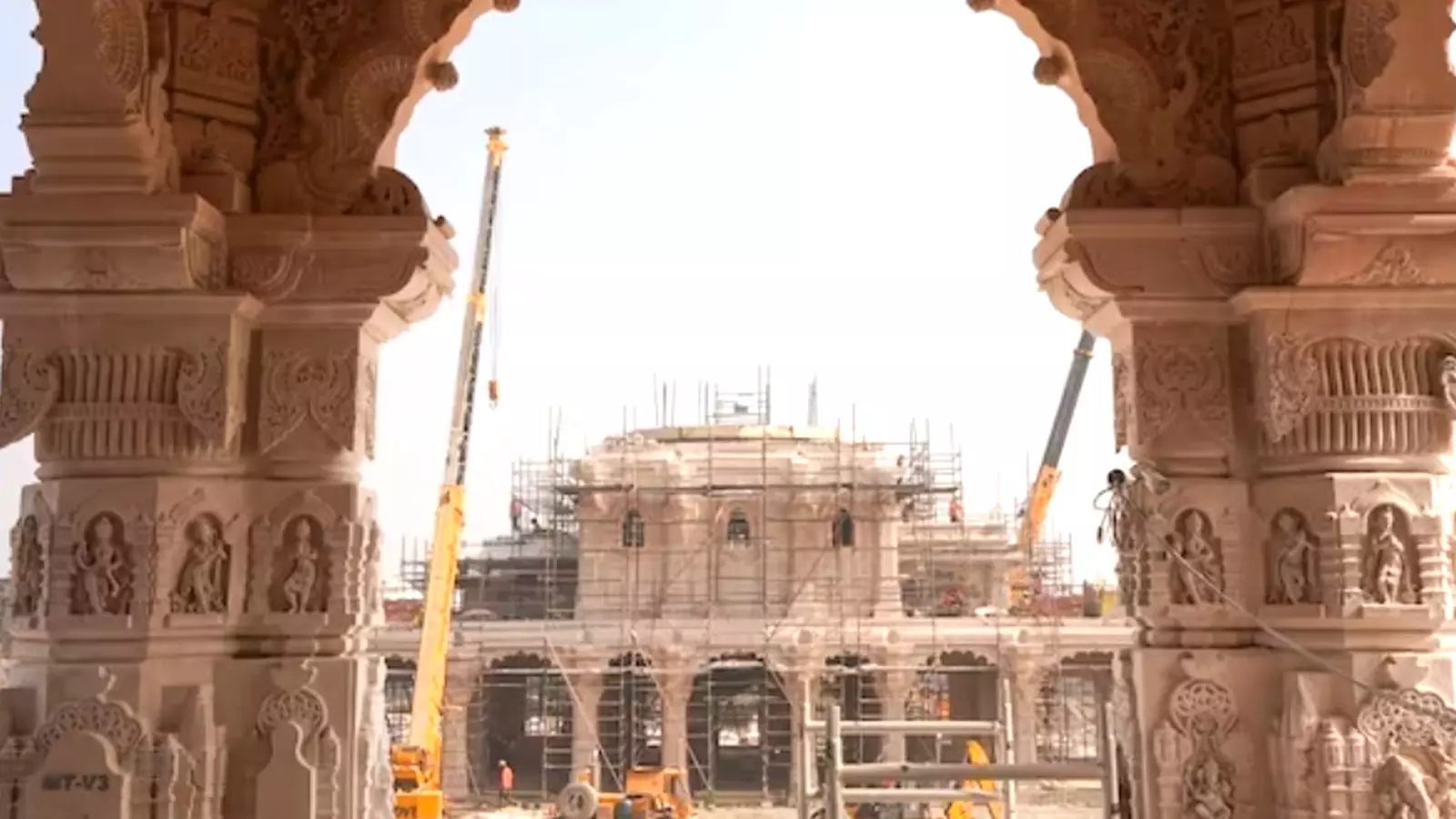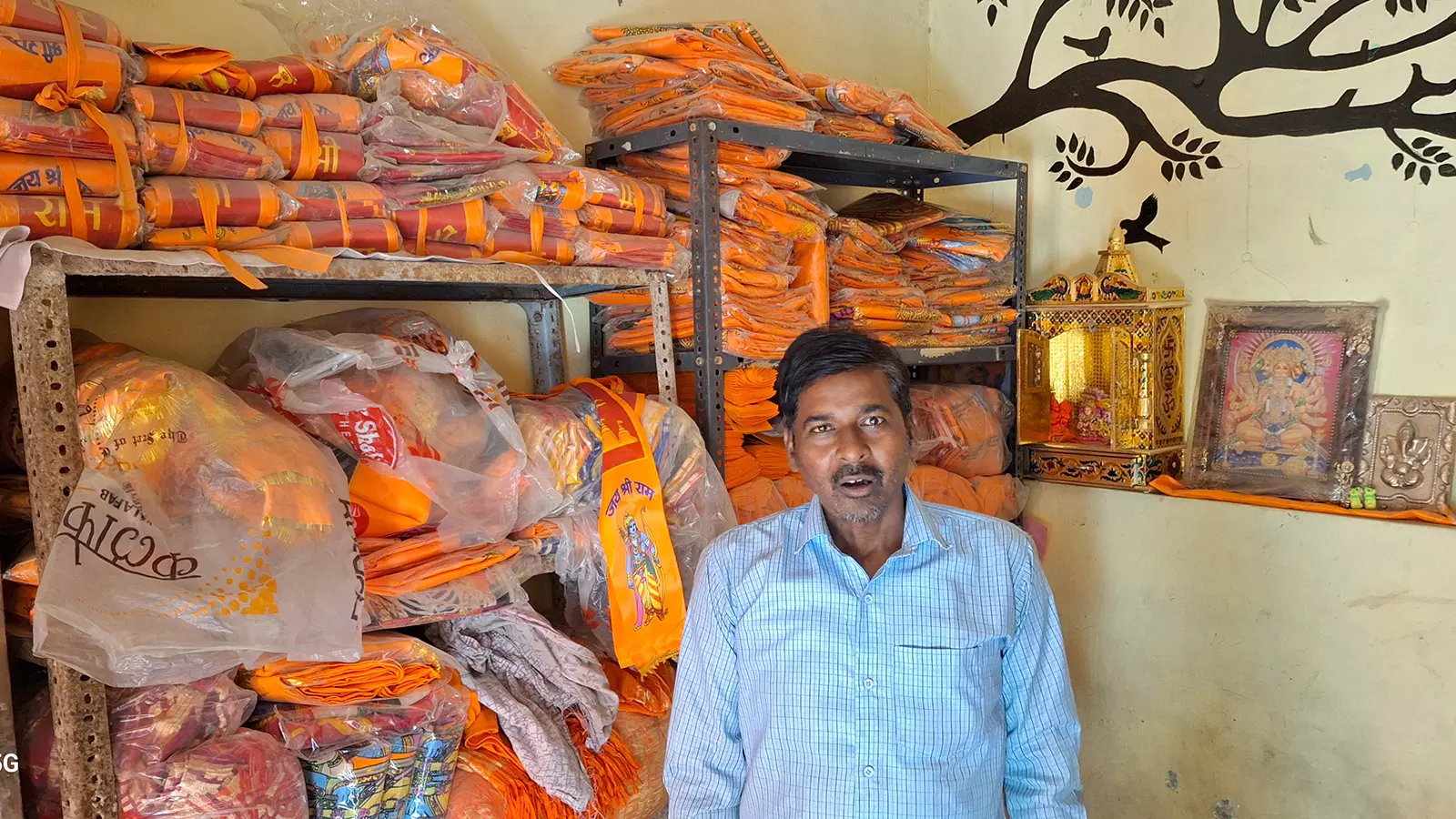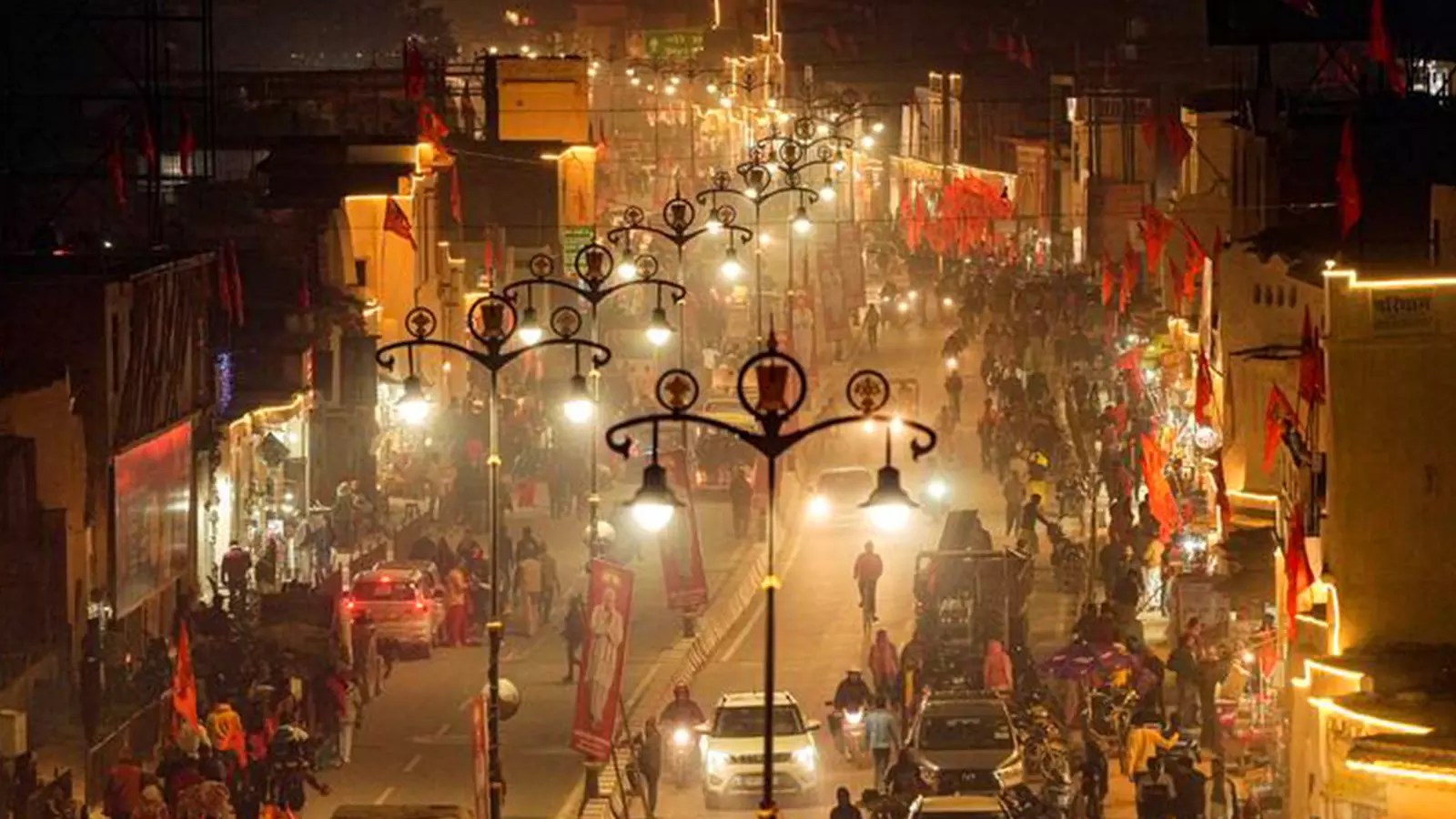
- Home
- India
- World
- Premium
- THE FEDERAL SPECIAL
- Analysis
- States
- Perspective
- Videos
- Sports
- Education
- Entertainment
- Elections
- Features
- Health
- Business
- Series
- In memoriam: Sheikh Mujibur Rahman
- Bishnoi's Men
- NEET TANGLE
- Economy Series
- Earth Day
- Kashmir’s Frozen Turbulence
- India@75
- The legend of Ramjanmabhoomi
- Liberalisation@30
- How to tame a dragon
- Celebrating biodiversity
- Farm Matters
- 50 days of solitude
- Bringing Migrants Home
- Budget 2020
- Jharkhand Votes
- The Federal Investigates
- The Federal Impact
- Vanishing Sand
- Gandhi @ 150
- Andhra Today
- Field report
- Operation Gulmarg
- Pandemic @1 Mn in India
- The Federal Year-End
- The Zero Year
- Science
- Brand studio
- Newsletter
- Elections 2024
- Events
No Ram Rajya in Ayodhya yet: Why Ram Mandir may not be enough to pull BJP through

It is not as if the locals of Ayodhya do not feel a surge of pride and a sense of jubilation over the long-awaited consecration of the opulent Ram Mandir, built on the site of the demolished Babri Masjid.Yet, now that the temple has finally come up on what many Hindus believe is the birth place of Lord Ram, it is the uncertainty of what follows next that boggles them. Travelling through...
It is not as if the locals of Ayodhya do not feel a surge of pride and a sense of jubilation over the long-awaited consecration of the opulent Ram Mandir, built on the site of the demolished Babri Masjid.
Yet, now that the temple has finally come up on what many Hindus believe is the birth place of Lord Ram, it is the uncertainty of what follows next that boggles them. Travelling through Ayodhya town, it isn’t difficult to decipher why.
The sharp contrasts that Ayodhya presents today are inescapable. If the Ram Mandir, though its construction is still far from complete, represents grandeur and extravagance, the town all around it is an image of chaos. The Ram Path and a few other recently widened arterial roads leading up to the temple offer a rare driving experience in a city of crowded bylanes where vehicular traffic often chugs slower than a cart with motorists and pedestrians exchanging words that are too colourful to be printed.
Look on either side of these remodelled arterial roads and you see a city unwilling to come to terms with its forced makeover and sceptical of the reality of the dream that is being sold on hoardings all across Ayodhya; branding this ‘Ram Nagri’ as the ‘perfect city’.
The fresh coat of yellow paint and black name plates that adorn the shops and residences lining either side of Ram Path, giving the thoroughfare a look of dreary uniformity, do little to hide traces of the demolition drive that had preceded this makeover. The half broken walls, caved in terraces and piles of rubble visible all along the roadside present a somewhat depressing image of a city ransacked by a local administration eager to take credit for Ayodhya’s ‘redevelopment’.

The Ram Mandir was inaugurated despite it still being under-construction. Photos: PTI
If this is just one half of the story; a portrait of today’s Ayodhya that betrays the political drumbeating around a city reclaiming its glorious past, the other half is replete with fears and anxieties of the temple town’s residents.
Nandu Gupta, whose shop is located just off the Jain Mandir Chauraha, a stone’s throw away from one of the entrances to the temple complex, told The Federal, “Ram par bahut rajneeti ho gayi, Mandir ke mudde par kitne chunav ho gaye... ab ban gaya naa, ab toh hamari baat honi chahiye (Enough politics has been played over Ram; many elections have been fought over the Mandir issue too... now that the temple has been constructed, the discourse should be on people’s issues).”
In fact, his loud proclamation is timidly backed by a few other shopkeepers as well. Gupta sells Jai Shri Ram, Ram Mandir and Ayodhya Dham flags, banners, posters and stoles.
The reason for his discontent is that the spike in business which Ayodhya’s shopkeepers witnessed in the two months after the temple’s inauguration has now begun to wane and so has the momentary boom in his earnings. On the other hand, the temple has led to “new challenges”.
“Everything is in a mess now. The administration has put so many restrictions on movement that the number of pilgrims has continued to fall steadily. Most Aastha trains (special trains started by the Union government to ferry pilgrims to Ayodhya) as well as flights that were launched for Ayodhya have stopped operations; there are only three regular flights to Ayodhya now,” said Gupta.
“Obviously business has been hit but the bigger cause of worry is that even pilgrims from Faizabad and around have reduced. Every few days there is some VVIP visiting the temple and everything comes to a halt,” added the shopkeeper.
Another shopkeeper who requested anonymity is also worried about the huge losses they were suffering due to the VVIP visits. He said, “The most important festival in Ayodhya is Ram Navmi and there is a big mela (fair) during that time for which Ram devotees from all nearby districts come. Before the temple was built, shopkeepers used to earn the equivalent of their two to three months’ worth of income during that one week of the mela but this time, it was a flop show. Only politicians and VVIPs came while restrictions were imposed on the common public. Every shopkeeper suffered huge losses.”
Suman Gupta, editor of Jan Morcha, a highly regarded Hindi daily across Faizabad, felt that though locals are happy the temple got constructed, residents and shopkeepers in the temple complex’s vicinity are upset over the demolition of their homes and shops and the poor compensation they received for it from the administration.
“Poor compensation or delay in payment of compensation continues to be a grouse with people who lost their homes and shops and there is a new fear now that further expansions of the Ram Path and other roads would lead to a second wave of destruction of homes and shops,” said Gupta. She added that these are concerns that no one in the state administration is addressing adequately; instead there have been several incidents of people being intimidated by the police and local administration for protesting on these issues.

Nandu Gupta, whose shop is located just off the Jain Mandir Chauraha, says enough politics has been played over Ram. Now that the temple has been constructed, the focus should be on people’s issues. Photo: Puneet Nicholas
Atul Mishra, a resident of Rikaabganj locality, told The Federal that he was among several Ayodhya locals who had participated in protests last year against the proposal of widening the Ram Path further. Kumar used to work at a shop on Ram Path, which had been partially demolished for the road’s first makeover. “The shop owner claimed he received only half the value of compensation that was owed to him. Due to that financial loss and the subsequent fall in his business, he claimed he could not retain his staff and so I along with two other workers lost our jobs,” Mishra said.
Mishra claimed that many of those who had joined the protests against Ram Path’s expansion were “harassed” by the police later. Nandu Gupta, who was also among the protesters, claimed electricity supply to his shop was disconnected and the “prashasan” (administration) started bombarding him with “recovery notices”. “All of a sudden, different departments started sending notices. They said I had not paid my electricity bill and then they cut power supply. Notices for non-payment of water bill and property tax were also sent shortly thereafter. I spent two months running from one department to the other showing receipts of all the payments I had made,” he said.
For Ayodhya’s Muslims, steadily pushed to the society’s margins since the demolition of the Babri Masjid and ghettoized in localities like Daurai Kuan and Panjitola, such intimidation is now part of routine life. Panjitola resident Mohammed Ismail says he has “made peace” with being harassed and intimidated by both, the administration and BJP supporters. “The Hindus still have the option to publicly express their concerns about what is happening in the city; we can’t even do that. The only way for us to survive is to keep our heads down and carry on with whatever we do… if our home or shop is being demolished, we can’t protest, if the police harass us, we just hope for it go get over soon,” Ismail said.
The Dhannipur Mosque
A similar pall of despondency prevails 25 kms away from Ayodhya town in Dhannipur village where, as per the Supreme Court’s verdict in the Ram Janmbhoomi-Babri Masjid title suit, five acres of land had been given by the state government to the UP Sunni Waqf Board for construction of a mosque in the interest of serving “complete justice” over the “criminal act” of the Babri’s demolition.
While the Ram Mandir has been consecrated and further construction is underway to complete the complex – no one really knows by when this would happen though – this Dhannipur Mosque remains a dream on paper; mired in bureaucratic hurdles and a paucity of funds. The Indo-Islamic Cultural Foundation (IICF), tasked with building the mosque in Dhannipur village, has been planning to launch a crowd-funding drive to raise funds but no forward movement has happened on this front either.
The mosque development committee has had its own share of internal turmoil; plagued as it was with differences among its members and with those of the IICF over the mosque’s name, its design and practically every other aspect of the ‘project’, which also involves the construction of a hospital, a library, a community kitchen and a research centre.
A member of the IICF who wished to remain anonymous told The Federal that there have been murmurs of the BJP “muscling its way in to take control” of the mosque project too because “whenever the work takes off, there will be a lot of money involved”. “The IICF and some members of the mosque development committee wanted the mosque to be named Masjid-e-Ayodhya while an alternative option was to name it after Maulvi Ahmadullah Shah (a cleric from Faizabad who was a prominent figure in the 1857 Indian freedom movement) but even this became a contentious point. Later, Arafat Shaikh (who took over as the mosque development committee chief in November 2023) unilaterally declared that the mosque will be called the Mohammad Bin Abdullah mosque. Shaikh also disapproved of the initial design of the mosque and got a Maharashtra-based architect to make a fresh blueprint,” the IICF member told The Federal.
Fears that the BJP, which along with members of the broader Sangh Parivar, was instrumental in the Babri Masjid’s demolition, was trying to seize control of the Dhannipur Mosque project gathered momentum after Arafat, a BJP politician from Maharashtra, took over as chief of the mosque development committee.
“Can there be a greater irony than a BJP leader heading the committee that will decide various aspects of the mosque’s construction? He is no association with Ayodhya or the various organisations that went to court against the Babri Masjid’s demolition. He is from Maharashtra and from what we know, he is getting people from Maharashtra to oversee different aspects of the construction,” a former member of the Babri Masjid Action Committee, a collective of organisations that fought the legal battle over the Babri’s demolition, told The Federal requesting that he not be identified because “I don’t want to get into unnecessary trouble”.
Locals in Dhannipur and the adjoining Ronahi, both Muslim dominated villages, had hoped that the mosque’s construction would create employment and help improve their lives. “It is a big project. It would have created so many jobs and once the construction was completed, the area would have developed which would have created further job opportunities but we are still waiting for things to take off,” said Dhannipur resident Afaaq Moin said.
The lack of job opportunities, however, isn’t a concern for Ayodhya’s Muslims alone. The Hindus, those living in Ayodhya town as well as others who reside in Milkipur, Rudauli, Bikapur and Dariyabad – the five assembly constituencies collectively make up the Faizabad Lok Sabha seat – lament growing unemployment equally.

The Ram Path in Ayodhya. Photo: PTI
“There are no jobs here, even in Ayodhya and even after the Ram Mandir. Development too has been very skewed with the government focusing entirely on the Ram Mandir and projects directly associated with it, such as the expansion of the railway station and Ayodhya airport, widening of roads etc, while other parts of Faizabad remain cut off from development. Nothing that would directly help in improving the people’s lives has been done,” says Anil Kumar Singh, a professor at Ayodhya’s KS Saket PG College.
Voting for the Faizabad Lok Sabha constituency concluded on May 20, sealing the fate of two-term incumbent MP and BJP candidate Lallu Singh and his main challenger, nine-term Samajwadi Party legislator Audhesh Prasad, the joint candidate of the SP and the Congress party. Whether this simmering discontent within Ayodhya and the wider Faizabad constituency helps Prasad wrest the seat or gets brushed aside by the BJP’s Jo Ram ko Layein Hain, Unko Layenge cacophony to give Singh a third consecutive Lok Sabha victory will be known on June 4.
